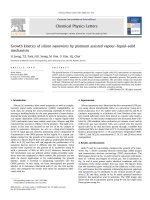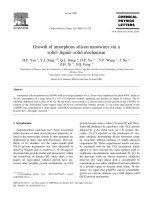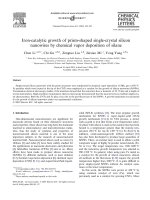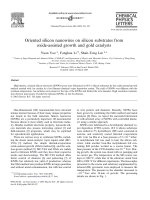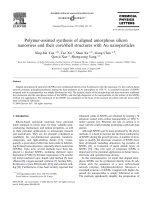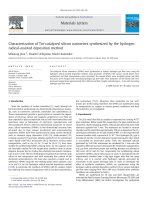- Trang chủ >>
- Khoa Học Tự Nhiên >>
- Vật lý
Controlled growth of oriented amorphous silicon nanowires via a solid–liquid–solid (SLS) mechanism
Bạn đang xem bản rút gọn của tài liệu. Xem và tải ngay bản đầy đủ của tài liệu tại đây (395.98 KB, 5 trang )
Physica E 9 (2001) 305–309
www.elsevier.nl/locate/physe
Controlled growth of oriented amorphous silicon nanowires
via a solid–liquid–solid (SLS) mechanism
D.P. Yu
a; ∗
, Y.J. Xing
a; b
, Q.L. Hang
a
, H.F. Yan
a
,J.Xu
a
, Z.H. Xi
b
, S.Q. Feng
a
a
Department of Physics, Electron Microscopy Laboratory and Mesoscopic Physics National Laboratory, Peking University,
Beijing 100871, China
b
Department of Electronics, Peking University, Beijing, China
Received 19 May 2000; received in revised form 19 July 2000; accepted 24 July 2000
Abstract
Highly oriented amorphous silicon nanowires (a-SiNWs ) were grown on Si (1 1 1). The length and diameter of oriented
SiNWs are almost uniform, which are 1 m and 25 nm, respectively. Dierent from the well-known vapor–liquid–solid (VLS)
for conventional whisker growth, it was found that growth of the a-SiNWs was controlled by a solid–liquid–solid mechanism
(SLS). This synthesis method is simple and controllable. It may be useful in large-scale synthesis of various nanowires.
? 2001 Elsevier Science B.V. All rights reserved.
PACS: 61.46.+w; 68.65.+g; 73.20.Dx; 78.55.−m
Keywords: Si nanowires; Quantum conÿnement eect; Low dimensionality
1. Introduction
Intensive research eorts on one-dimensional nano-
materials have been carried out since the ÿrst pio-
neering work of the discovery of carbon nanotubes
by Iijima [1] and other quasi-one-dimensional nanos-
tructures such as silicon nanowires (SiNWs) [2,3].
Because bulk Si is an indirect gap material, the SiNWs
are useful one-dimensional nanostructure for tailoring
its physical properties from indirect to direct band gap.
The synthesis of Si whiskers via the vapor–liquid–
solid (VLS) growth mechanism was ÿrst described in
∗
Corresponding author. Fax: +86-10-6275-1615.
E-mail address: (D.P. Yu).
detail by Wagner and co-workers [4,5]. Givargizov
developed the growth model and discussed it within
a kinetics framework [6]. Yazawa [7] and Westwater
[8], and Ozaki [9] produced SiNWs with VLS growth
induced by Au metal layer on a Si surface. Recently,
Yu et al. reported oven-laser ablation method through
simple physical evaporation approach [2,10], to pro-
duce very pure ultraÿne freestanding SiNWs. In the
previous work for SiNWs synthesis, however, vapor
phase with considerable Si concentration was either
supplied from laser ablation of a powder target, or
directly from silane. In this paper, we report that
oriented a-SiNWs can be controllably grown on a
silicon substrate via a solid–liquid–solid (SLS)
growth mechanism.
1386-9477/01/$ - see front matter ? 2001 Elsevier Science B.V. All rights reserved.
PII: S 1386-9477(00)00202-2
306 D.P. Yu et al. / Physica E 9 (2001) 305–309
2. Experimentals
Heavily doped (1:5 × 10
−2
=cm) n-type Si (1 1 1)
chips wafers were used as substrate. The silicon subs-
trate was cleaned ultrasonically in pure petroleum
ether and in ethanol in turns for 5 min, and leached
in distilled water, then dried. A thin layer of 40 nm
nickel was thermally deposited on the substrate. The
substrate was placed in a quartz tube which was heated
in a tube furnace at 950
◦
C. Ar (36 sccm) and H
2
(4
sccm) were introduced during growth at an ambient
pressure of about 200 Torr. After cooling down to
room temperature, a thin layer of gray-colored deposit
was found on the surface of the substrate. An Am-
ray FEG-1910 scanning electron microscope (SEM),
and a Hitachi-9000NAR high-resolution transmis-
sion electron microscope (HREM) equipped with
energy-dispersive spectrum (EDS) were employed
for analysis of the morphology and microstructure of
the product.
3. Results and discussions
Fig. 1(a) shows plan view of SEM image revealing
the general morphology of the SiNWs grown on a
large area (10 mm × 10 mm) of 111 Si substrate. The
nanowires grew directly on the substrate. It is visible
that the deposit consists of pure SiNWs. The growth
rate of the nanowires is estimated to be about 30 nm=s.
EDS analysis (inset) proved that the nanowires are
composed of Si, but there exists a small amount of
oxygen in the SiNWs, which was attributed to the
surface oxidation sheathing the nanowires. The TEM
image shown in Fig. 1(b) reveals that the SiNWs have
diameter between 10 and 50 nm, and length up to a
few tens micrometers. The highly diusive ring pattern
(inset) of selected area electron diraction (SAED)
revealed that the SiNWs are completely amorphous
(a-SiNWs).
To control the orientation of the a-SiNWs, a
three-step heating procedure was involved in the
growth of the oriented a-SiNWs. Firstly, the system
was heated to 800
◦
C, and a mixture of H
2
(36 sccm)=
Ar (4 sccm) was introduced to the tube. The tem-
perature was then raised from 800
◦
Cto950
◦
C and
pure Ar (100 sccm) was used as a carrier gas in
this step. The ambient pressure of the tube was
Fig. 1. (a) SEM micrograph showing the general morphology of
the SiNWs grown via a SLS growth mechanism. The inset shows
EDS spectrum with the peak corresponding to Si, (b) TEM image
revealing that the SiNWs have smooth morphology and average
diameter around 40 nm. The SAED pattern shown in inset reveals
characteristic diusive ring pattern, showing that the nanowires
are completely amorphous.
kept near 750 Torr by adjusting the exit valve,
then the tube was evacuated. This procedure was
repeated three times. Finally, the temperature was
held at 950
◦
C at the pressure of about 200 Torr for
1 hr. A mixture of H
2
(4 sccm) and Ar (36 sccm) was
introduced to the tube.
A low-magniÿed SEM image of the oriented
a-SiNWs is shown in Fig. 2(a), representing a gen-
eral planar view of the oriented a-SiNWs. It is visible
that the nanowires were grown on centimeter-sized
substrate. An interesting phenomenon is that the
nanowire ÿlm was found chapped in a network
of white-contrasted lines. The inclined view at a
crossover point of the white in Fig. 2(b) revealed the
white lines are in fact V-shaped chaps. From this im-
age it is visible that the ÿlm consists of pure SiNWs.
D.P. Yu et al. / Physica E 9 (2001) 305–309 307
Fig. 2. (a) SEM image of oriented SiNWs on the substrate (top
view, low magniÿcation), regions except white lines are composed
of SiNWs perpendicular to the substrate. The length of SiNWs
is about 1 m, (b) SEM image of a cross part of the grooves.
SiNWs on the edge of grooves fall on to the substrate, (c) TEM
image of SiNWs with average diameter around 25 nm, which were
scrapped from the substrate. The SAED pattern shown in inset
reveals characteristic ring pattern, showing that the nanowires are
completely amorphous (a-SiNWs).
Parts of a-SiNWs on the edge of chaps fall on the
substrate. Fig. 2(c) is the TEM image of ultraÿne
SiNW, which were scratched from the substrate. It
shows that the diameter of a-SiNWs is about 25 nm.
The highly diusive ring pattern (inset) in select area
electron diraction (SAED) revealed that SiNWs are
completely amorphous. Though the reason why the
resultant nanowires are amorphous instead of being
crystalline is not yet very clear, the authors think that
amorphous state was closely related to the fast growth
speed in the present condition.
It was found that the growth of the amorphous
SiNWs here is dierent from the VLS mechanism
for conventional whiskers [4–6], revealing a dier-
ent growth mechanism. In the case of oven-laser abla-
tion approach [1,2], silicon source for SiNWs growth
was supplied from the vapor phase in which atomic
Si species were ablated o by the laser beam, and the
growth of the SiNWs is controlled by the well-known
VLS mechanism. The central idea of the VLS growth
of SiNWs is that, the catalysts (usually Ni, or Fe as
impurity) act as a liquid-forming agent, which reacts
with the vapor phase, and forms the NiSi
2
eutectic liq-
uid droplets. The vapor phase is rich in Si atoms. With
the further absorption of Si atoms into the droplets
from the vapor phase, the droplets become supersat-
urated, resulting in the precipitation of SiNWs from
the droplets.
In the present circumstance, however, the Si con-
centration in the vapor phase is negligible at the
growth temperature, because the speciÿc surface=
volume ratio of bulk Si substrate is extremely low.
On the other hand, the Si substrate was covered by a
thin layer of Ni. Therefore, the only possible silicon
source comes from the bulk silicon substrate, because
no extra Si source was introduced in the vapor phase.
From the binary Ni–Si diagram, it is visible that the
eutectic point of Si
2
Ni is 993
◦
C. However, due to
the melting eect of small-size grains, the eutectic
compound NiSi
2
can begin to form at a temperature
lower than 993
◦
C. As we proved, the deposited Ni
ÿlm can react with the Si substrate at temperature
above 930
◦
C, and forms Si
2
Ni eutectic liquid alloy
droplets. Because of the relatively high solubility
of Si in Si
2
Ni eutectic alloy, more Si atoms will
diuse through the solid (the substrate) –liquid inter-
face into the liquid-phase (the Ni Si
2
droplets). A
second liquid–solid (nanowire) interface will form
when the liquid phase becomes supersaturated due
to thermal or compositional uctuations, resulting in
the growth of SiNWs. Because this growth process
involves solid–liquid–solid phases, it is named as a
SLS growth, which is in fact an analogy of the VLS
mechanism. The growth process of the a-SiNWs via
an SLS model is depicted schematically in Fig. 3.
Cross-sectional SEM analysis of the sample pro-
vided direct evidence to support the a-SiNW growth
308 D.P. Yu et al. / Physica E 9 (2001) 305–309
Fig. 3. Schematic depiction of the SiNW growth via the SLS mechanism: (a) deposition of a thin layer of Ni on the Si (111) substrate;
(b) formation of the Si–Ni eutectic liquid droplets; (c) the continuous diusion of Si atoms through the substrate–liquid (S–L) interface;
(d) ÿnal state of the SiNW growth. The smooth surface of the original substrate becomes rough at the end of the SiNW growth.
via a SLS mechanism. Fig. 4(a) shows an SEM
image of oriented a-SiNWs grown on the substrate
(cross-sectional view). The a-SiNWs grew densely
and are all perpendicular to the substrate. The length
of the SiNWs is about 1 m. It is visible that be-
tween the SiNWs and the substrate there is a layer of
nano-sized particles which proved to consist of Ni and
Si. Fig. 4(b) shows a low-magniÿed cross-sectional
SEM image. It is visible that a layer of oriented
a-SiNWs was grown on the substrate. EDS analysis
between the Si substrate and the a-SiNW layer further
conÿrmed that there is a thin layer of Si–Ni alloy,
which is indicated with a white arrow. We found that
the a-SiNWs grow from base, which manifests itself
by the fact that the solidiÿed Si–Ni nano particles
were visible between the surface of the substrate and
the a-SiNW ÿlm, instead of being attached at the free
tip of the SiNWs.
The SiNWs are interesting to evaluate the quantum
conÿnement eect related to materials of low dimen-
sionality [10,11]. The a-SiNWs grown on substrate
have remarkable surface= volume ratio, possibly show-
ing physical–chemical properties completely dierent
from the bulk. From this point of view, it is speculated
that the a-SiNWs may have potential applications such
as rechargeable battery of high capacity with portable
size, which is closely related to the surface eects. In
fact, it was recently revealed that the lithium battery
using SiNWs as electrode materials showed a capacity
as high as 8 times than that of the ordinary one [12].
Fig. 4. (a) Low and (b) magniÿed cross-sectional SEM images of
the SiNWs grown on Si (111) substrate, which is controlled by
a SLS mechanism. The length of the SiNWs is about 1 m. The
Si–Ni particles are visible attached to the Si substrate surface.
D.P. Yu et al. / Physica E 9 (2001) 305–309 309
By optimizing dopants, it is believed that the a-SiNW
ÿlm thus prepared will ÿnd applications in future
nanotechnology.
4. Summary remarks
In summary, oriented silicon nanowires have been
grown using Si substrate as Si source via a solid–
liquid–solid mechanism by heating. They have uni-
form length and diameter. The growth is explained
by solid–liquid–solid model. This synthesis method of
oriented SiNWs is simple and controllable. It can also
be used to synthesize other nanowires.
Acknowledgements
This project was ÿnancially supported by national
Natural Science Foundation of China (NSFC), and by
the Research Fund for the Doctoral Program of higher
Education (RFDP), China.
References
[1] S. Iijima, Nature 354 (1991) 56.
[2] D.P. Yu, C.S. Lee, I. Bello, X.S. Sun, Y.H. Tang, G.W.
Zhou, Z .G. Bai, Z. Zhang, S.Q. Feng, Solid State Commun.
105 (1998) 403.
[3] D.P. Yu, Z.G. Bai, Y. Ding, Q.L. Hang, H.Z. Zhang, J.J.
Wang, Y.H. Zou, W. Qian, H.T. Zhou, G.C. Xiong, S.Q.
Feng, Appl. Phys. Lett. 72 (1998) 3458.
[4] R.S. Wager, W.C. Ellis, Appl. Phys. Lett. 4 (1964) 89.
[5] R.S. Wager, W.C. Ellis, Trans. Metall. Soc. AIME 233 (1965)
1053.
[6] E.I. Givargizov, J. Crystal Growth 31 (1975) 20.
[7] M. Yazawa, M. Koguchi, A. Muto, M. Ozawa, K. Hiruma,
Appl. Phys. Lett. 61 (1992) 2051.
[8] J. Westwater, D.P. Gosain, S. Tomiya, S. Usui, H. Ruda,
J. Vac. Sci. Technol. B 15 (1997) 554.
[9] N. Ozaki, Y. Ohno, S. Takeda, Appl. Phys. Lett. 73 (1998)
3700.
[10] D.P. Yu, Z.G. Bai, J.J. Wang, Y.H. Zou, W. Qian, J.S. Fu,
H.Z. Zhang, Y. Ding, G.C. Xiong, S.Q. Feng, Phys. Rev. B
59 (1999) 2498.
[11] J. Hu, M. Ouyang, P. Yang, C.M. Lieber, Nature 399 (1999)
48.
[12] G.W. Zhou, H. Li, H.P. Sun, D.P. Yu, Y.Q. Wang, L.Q.
Chen, Ze Zhang, Appl. Phys. Lett. 75 (1999) 2447.

